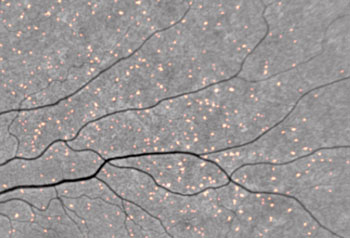Retinal Imaging Detects Changes Associated with Alzheimer's Disease
By MedImaging International staff writers
Posted on 23 Jul 2014
A noninvasive optical imaging device can provide early detection of changes that later occur in the brain and are a classic sign of Alzheimer's disease (AD), according to a new study.Posted on 23 Jul 2014
Researchers at the Commonwealth Scientific and Industrial Research Organization (CSIRO, Melbourne, Australia) conducted a study to measure retinal beta-amyloid plaque in 40 volunteers, using a fluorescence-based scan that was compared to the results of brain positron emission tomography (PET) scans using the Pittsburgh Compound B (PiB) amyloid tracer. The researchers used orally administered curcumin as a tracer, on the basis of previous research indicating that it binds beta-amyloid protein with high affinity.

Image: Amyloid plaques showing up in retinal scan as fluorescent spots as curcumin binds to them (Photo courtesy of CSIRO).
The researchers found that besides correlating strongly with plaque burden estimates from PiB-based PET scans, the retinal scans distinguished patients with AD from other participants with 100% sensitivity and a specificity of 80.6%. For the study, the researchers used the NeuroVision system, a product of NeuroVision Imaging (Sacramento, CA, USA), which provides a count of beta-amyloid plaques in the retina, their two-dimensional (2D) extent in square microns, and their distribution. All three parameters are combined into a "retinal amyloid index" to provide a single-number estimate of beta-amyloid plaque burden.
The Australian study is one of several in progress to determine if similar results can be confirmed in humans living with the disease. The study involves a total of 220 patients composed of diagnosed with AD, including a group with mild cognitive impairment, another group of people with no evidence of brain abnormality, and controls. The study was presented at the Alzheimer's Association International Conference, held during July 2014 in Copenhagen (Denmark).
“All people with the disease tested positive and most of the people without the disease tested negative,” said lead author and study presenter Shaun Frost, MSc, BSc, a biomedical scientist at CSIRO. “The optical imaging exam appears to detect changes that occur 15–20 years before clinical diagnosis. It's a practical exam that could allow testing of new therapies at an earlier stage, increasing our chances of altering the course of Alzheimer's disease.”
“PET scans require the use of radioactive tracers, and cerebrospinal fluid analysis requires that patients undergo invasive and often painful lumbar punctures,” said Prof. Keith Black, MD, chair of the department of neurosurgery at Cedars-Sinai Hospital (Los Angeles, CA, USA), who helped develop the NeuroVision system. “The retina, unlike other structures of the eye, is part of the central nervous system, sharing many characteristics of the brain. By staining the plaque with curcumin […] we could detect it in the retina even before it began to accumulate in the brain.”
Curcumin, a major component of the yellow Indian spice turmeric, has fluorescent properties, and is also believed to have a variety of medicinal qualities.
Related Links:
Commonwealth Scientific and Industrial Research Organization
NeuroVision Imaging














